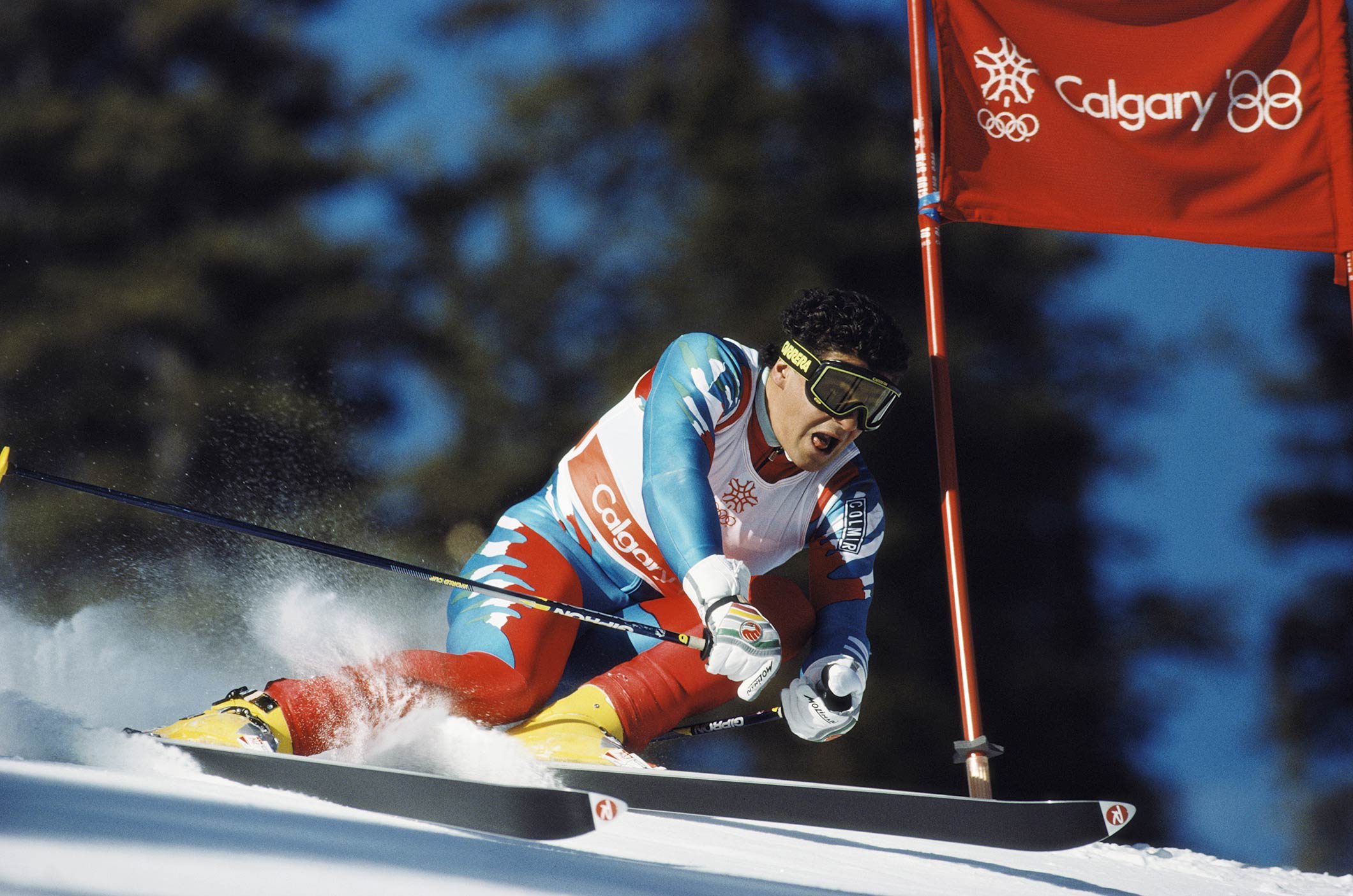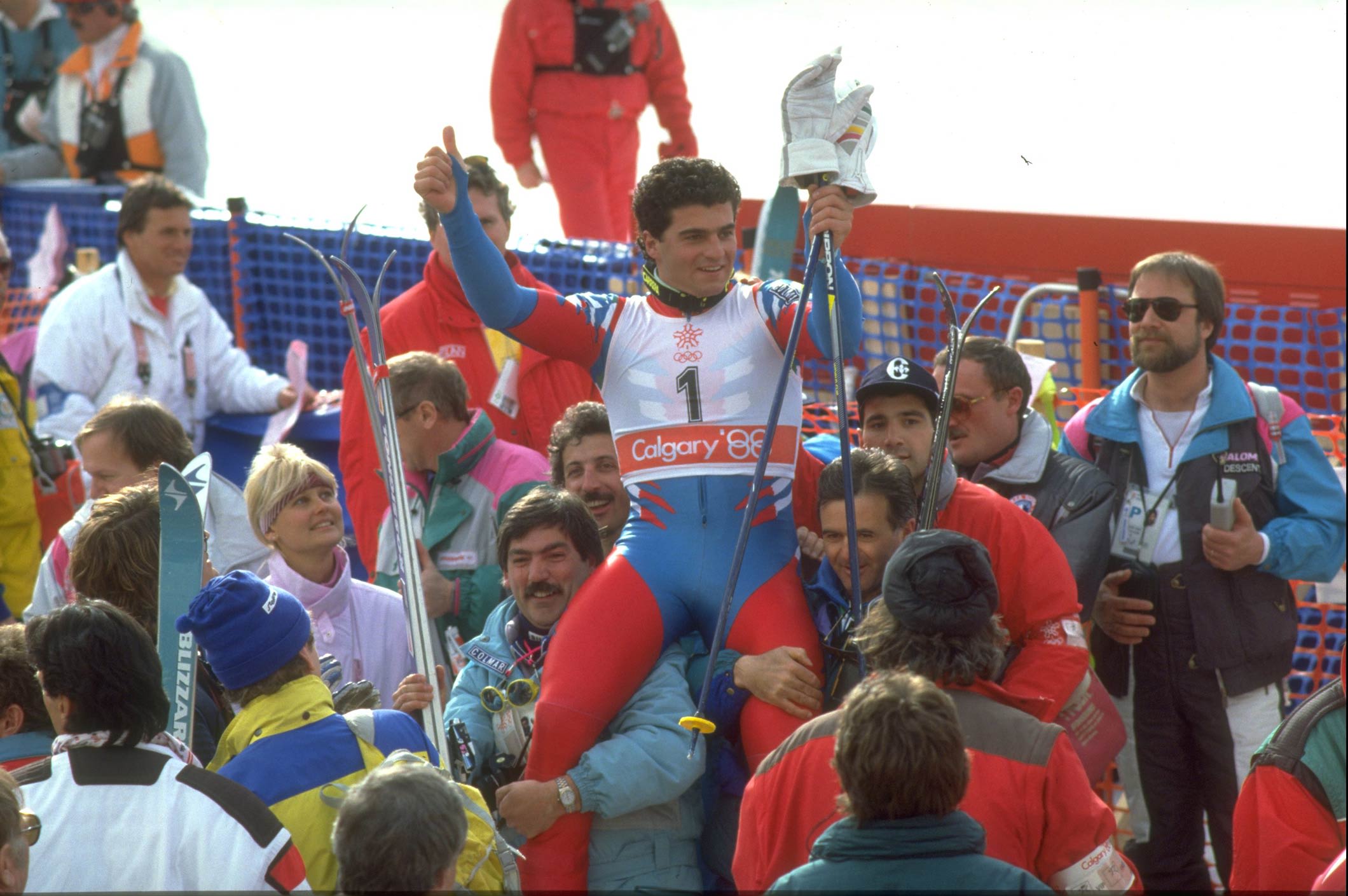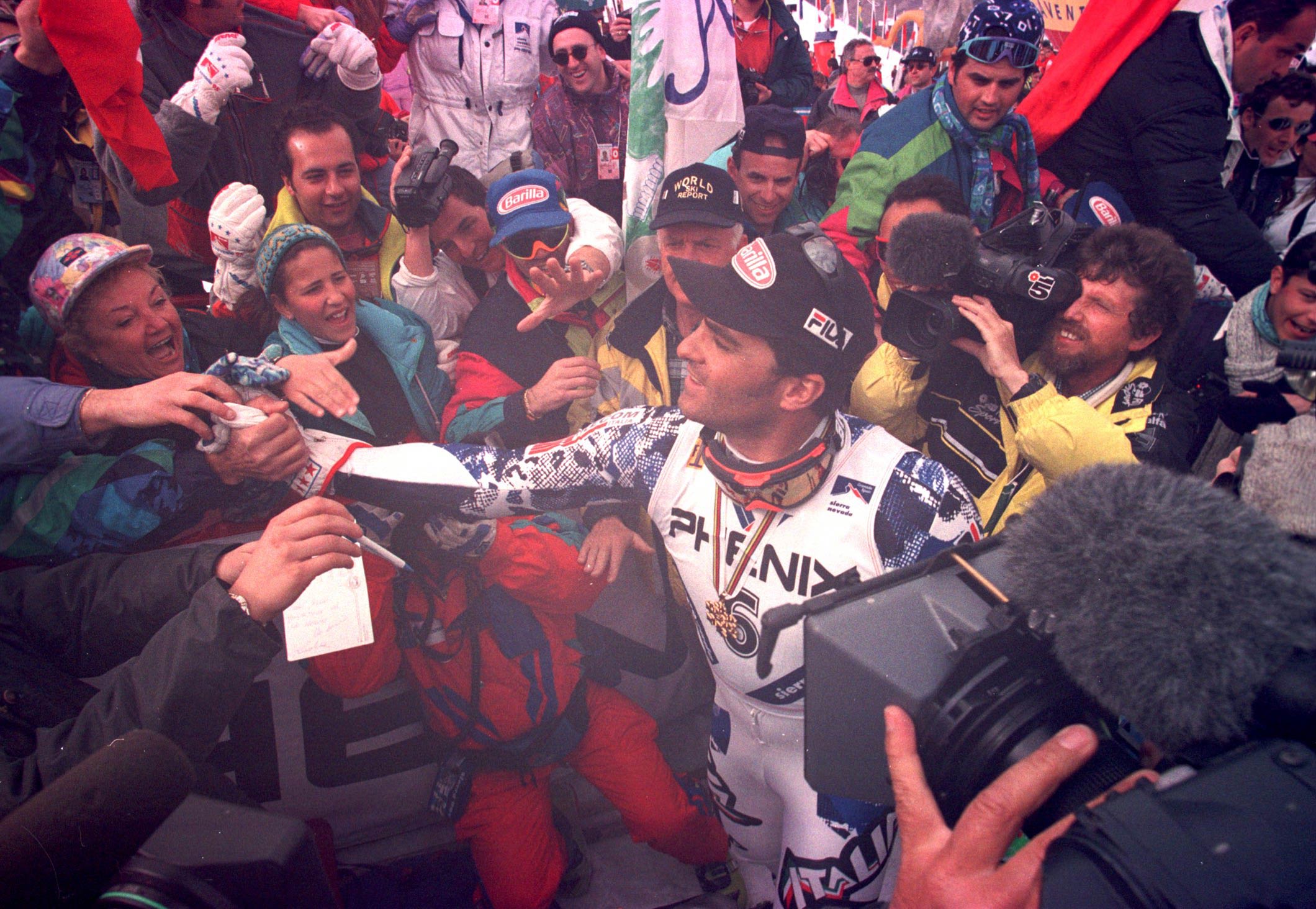When Alberto Tomba burst onto the Olympic scene 32 years ago…
He is one of the greatest Alpine skiers in history. Alberto Tomba competed in his first Games at Calgary in 1988, and within the space of 48 hours, between 25 and 27 February, he won the giant slalom and the slalom. He became “La Bomba”, a huge star in Italy and within his sport, and continued to produce stellar performances for the next 10 years.
Alberto Tomba is an unusual Italian skier, and one of the greatest champions in the history of his sport, very different from his mountain-born compatriots, many of whom are from the Trentino-Alto Adige (South Tyrol) region, and generally taciturn in nature. Tomba is a true son of Bologna, from a well-to-do family, born on 19 December 1966. He showed a natural talent for sport, and quickly pursued his passion for skiing on the nearby slopes of the Apennines, then in Cortina d'Ampezzo, where his father, who had made his fortune in the textile industry, procured him the services of a special teacher, Roberto Siorpaes, a former national team slalom skier in the 1950s and 60s.
Tomba was born to ski, and as he explains: “The intensive training started quickly. The coaches said I had a feeling for snow, and a special talent for skiing, so it was time for me to learn the right set-up so that I could fulfil my potential. My dad was a childhood friend of Roberto Siorpaes, and I started training with him at the age of seven.”
On this day 28 years, Alberto Tomba "La bomba" won his 3rd Olympic Gold medal in Alpine Skiing (giant slalom)! ⛷️ @fisalpine pic.twitter.com/HH4VNK0xkU
— Olympics (@Olympics) February 18, 2020
He continues: “A few years later, I was taking part in my first races near where I lived, in the Apennines of Emilia Romagna. I didn’t have much time to study, and I skived off school to train or take part in races. And even though I regret that now, it wouldn’t have been possible to do both properly. So I chose skiing. I well remember those first races, winning, losing, training. It all seemed like a game to me. Until things started to get serious…”
In his specialities of giant slalom and slalom (his mother, Maria Grazia, always refused to let him take the risk of trying downhill), he achieved some excellent international results at junior level. After taking part in the FIS Europa Cup in 1984, where he achieved several wins, he joined the national team in 1986. In his first World Cup season, he achieved his first podium finish, coming second in the giant slalom at Alta Badia on 14 December 1986.

The year he reached the top and achieved an Olympic double
During the 1987-1988 Olympic season he found his elite form, so by the time he arrived in Calgary for his first Games, he had already amassed seven wins, four in the slalom and three in the giant slalom, between the end of November and the middle of January. With his explosive style soon to earn him his famous nickname, at the age of 21 he was one of the favourites in the events contested on the slopes of Nakiska. “Calgary was really fun for me. I’d never won an international race until just a few months before the Games. It was all totally new for me, so totally unforgettable,” he recalls.
On 25 February, wearing bib number 1, he tore through the first leg of the giant slalom with a time of 1:03.91, more than a second faster than all his rivals. In the second act, Austria’s Hubert Strolz posted the fastest time, but Tomba was just one tenth of a second behind, so won with a total lead of 1.04 seconds. Switzerland’s Pirmin Zurbriggen took the bronze medal, with a gap of more than two seconds. He thus became only the second Italian Olympic champion in this discipline, after Gustavo Thöni (who later became his coach) in 1972.

Two days later, on Saturday 27 February 1988, it was time for the slalom. He started wearing bib number 11. This time, things were much harder, and Tomba finished only third in the first leg. Ahead of him were Sweden’s Jonas Nilsson and Germany’s Frank Wörndl, a more experienced skier who was 0.63 seconds faster than Tomba. In the second leg, legendary Swedish skier Ingemar Stenmark produced the fastest time, with Tomba second, 0.34 seconds behind. Meanwhile, Wörndl seemed to have felt the pressure and could manage only eighth place.
And so Tomba beat Wörndl by just 0.06 seconds, with Paul Frommelt of Liechtenstein taking the bronze, 0.37 seconds slower. Stenmark, the last man to achieve a slalom and giant slalom double (in 1980 at Lake Placid), was fifth. That made Alberto Tomba one of the great stars of these Games, and he became a huge sporting idol in Italy, earning the nickname that would remain with him throughout his career: “la Bomba”. But this was just the start of a fantastic Olympic and world career for an athlete known also for his exuberance. “In Calgary, I threw a huge party to celebrate my two wins. But what people don’t know is that I always celebrate, so I’d have had the party even if I’d lost!”
Alberto Tomba's gold medal giant slalom run | Calgary 1988
The only skier to retain his Olympic giant slalom title, a comeback in Lillehammer
After his Olympic double in Alberta, “la Bomba” became the best technical skier in the world. He racked up victories on all the courses in his two specialties, winning World Cup crystal globes in each. At the 1992 Games in Albertville, he emerged the winner in the giant slalom after an epic battle with Marc Girardelli and Kjetil Andre Aamodt on the fearsome Face de Bellevarde in Val d'Isère. Tomba thus became the first – and so far only – skier in history to retain his title in this discipline! In the slalom at Les Ménuires, where his supporters were present in force to create a football stadium atmosphere, he placed sixth in the first leg, but first in the second. He was beaten by 0.28 seconds by Norway’s Finn Christian Jagge. Two Games, four medals and three wins; but it wasn’t over yet!
At the 1994 Games in Lillehammer, he began by trying to achieve a hat-trick in the giant slalom. A series of errors saw him place only 13th in the first leg. He gave it all he had in the second act, only to miss the last gate but one! In the slalom at Hafjell, which he started wearing bib number 1, 11 skiers were in front of him by the end of the first leg. Austria’s Thomas Stangassinger had the best time, 1.84 seconds ahead. Once again, la Bomba attacked his way down the slope, and waited. One by one, the other skiers failed to beat his time. All except Stangassinger, who was still 0.15 seconds ahead when he crossed the finish line.
The final blaze of glory
The five-time Olympic medallist enjoyed some of his finest hours at the end of his international career. He even managed to win the overall title in the World Cup in the 1994-1995 season despite competing in just two disciplines, with seven slalom and four giant slalom wins. And despite never previously winning at the FIS World Championships, he won the giant slalom and the slalom in Sierra Nevada (Spain) in 1996.

He made a further Olympic appearance at Nagano in 1998, but failed to finish either of his two events; and then he ended his career by winning his last-ever race, the slalom in Crans Montana on 15 March 1998.
With 50 wins and 88 podium finishes in the World Cup, eight crystal globes and one overall title, two world titles, and three gold and two silver medals at the Olympic Games, Alberto Tomba is the greatest Italian Alpine skier of all time and an unforgettable champion, a real star who made a lasting mark on his own sport and far beyond.